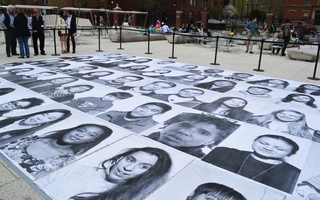Around a Mass. Hall conference table two weeks ago sat a dozen men and women steeped in culture and the finer arts.
The director of the Harvard University Art Museums was there, the man who oversees its vast empire of 160,000 pieces. So was the head of the Office for the Arts, who ensures that undergraduates have the resources they need to pursue their creative ventures. As was the executive director of the American Repertory Theatre, Cambridge’s premiere theater troupe. And the head of the Peabody, Harvard’s world-renowned anthropological museum.
This long-awaited meeting assembled the biggest players in the high-stakes battle that’s taking shape over how culture will fit into Harvard’s new Allston campus.
The dozen arts leaders had met twice before, last spring, and they had expected to reconvene the Advisory Group on Physical Planning for Arts, Culture and Museums again early this fall.
But as the meeting was postponed, they began to wonder what had happened and worry about losing the momentum they had built last spring.
In the meantime, the needs had grown more acute on all sides.
The art museums had expected to enter this semester ready to build a major modern art museum in Cambridge, but the whole idea was scrapped over the summer in the face of relentless community protests.
Meanwhile, student dancers began to realize that their prized Rieman Dance Center would be turned over to the Radcliffe Institute for Advanced Study in just over two years and that a replacement was nowhere to be found.
Allston holds promise for securing these arts institutions the space they so desperately desire, but the campus arts worry about winding up across the river from students’ daily lives.
When Harvard has tried to expand in recent years, the focus has been on constant clash between the University and the city of Cambridge. But when it comes to divvying up space for the arts in Allston, the first and most formidable challenge will be getting the University to agree with itself.
“A university committee takes a notoriously long time to complete its business, especially when, as in this case, there are so many different and even competing agendas,” art museums Director James Cuno wrote in an e-mail. “Working through the university process will be just as cumbersome as working through the public process.”
The difficulties of planning make committee members pause before investing too much hope in Harvard’s latest venture.
Nevertheless, around the table last month, they spent two-and-a-half hours launching into that process full throttle, jockeying for influence with the central administrators who will determine Allston’s future this summer—arts and all.
Museums Maneuver for Space
One battle line falls between student group interests and the expansion of Harvard’s established cultural institutions.
Read more in News
Student Launches Website For Feedback on CoursesRecommended Articles
-
 Arts Weekend Kicks Off
Arts Weekend Kicks Off -
Recruited Alums Unite for a January JAMSessionThis Wintersession, Harvard students have the opportunity to experience a dose of Hollywood and the Boston art scene with the ...
-
Arts Year In ReviewCrimson Arts takes stock of 2013.
-
 Trumpets Herald New Office of the Arts Ceramics Studio in Allston
Trumpets Herald New Office of the Arts Ceramics Studio in Allston -
Margaret Atwood Awarded 2014 Harvard Arts MedalAcclaimed author Margaret E. Atwood was honored with the 2014 Harvard Arts Medal in a ceremony Thursday to mark the beginning of the 22nd Annual Arts First Festival.
-
 Arts First Draws Half of Harvard Undergrads
Arts First Draws Half of Harvard Undergrads













